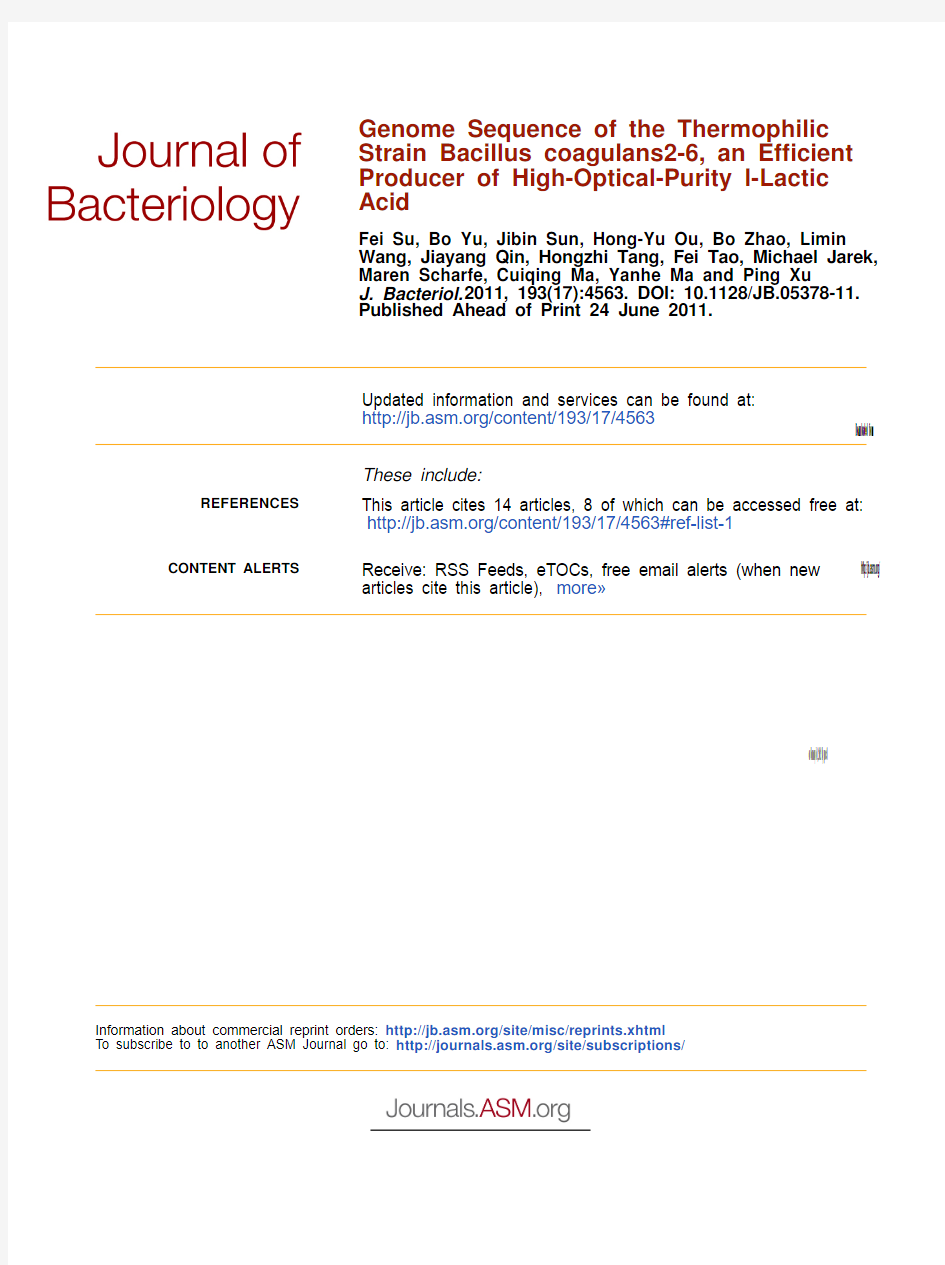Genome Sequence of the Thermophilic Strain Bacillus coagulans 2-6,


Published Ahead of Print 24 June 2011. 2011, 193(17):4563. DOI: 10.1128/JB.05378-11.
J. Bacteriol. Maren Scharfe, Cuiqing Ma, Yanhe Ma and Ping Xu Wang, Jiayang Qin, Hongzhi Tang, Fei Tao, Michael Jarek, Fei Su, Bo Yu, Jibin Sun, Hong-Yu Ou, Bo Zhao, Limin Acid Producer of High-Optical-Purity l-Lactic Strain Bacillus coagulans2-6, an Efficient Genome Sequence of the Thermophilic https://www.360docs.net/doc/23484204.html,/content/193/17/4563Updated information and services can be found at: These include:
REFERENCES https://www.360docs.net/doc/23484204.html,/content/193/17/4563#ref-list-1
This article cites 14 articles, 8 of which can be accessed free at:CONTENT ALERTS
more?articles cite this article), Receive: RSS Feeds, eTOCs, free email alerts (when new https://www.360docs.net/doc/23484204.html,/site/misc/reprints.xhtml Information about commercial reprint orders: https://www.360docs.net/doc/23484204.html,/site/subscriptions/
To subscribe to to another ASM Journal go to: on January 16, 2012 by guest
https://www.360docs.net/doc/23484204.html,/Downloaded from
J OURNAL OF B ACTERIOLOGY,Sept.2011,p.4563–4564Vol.193,No.17 0021-9193/11/$12.00doi:10.1128/JB.05378-11
Copyright?2011,American Society for Microbiology.All Rights Reserved.
Genome Sequence of the Thermophilic Strain Bacillus coagulans2-6, an Ef?cient Producer of High-Optical-Purity L-Lactic Acid?
Fei Su,1Bo Yu,2Jibin Sun,3Hong-Yu Ou,1Bo Zhao,2Limin Wang,2Jiayang Qin,3Hongzhi Tang,1 Fei Tao,1Michael Jarek,5Maren Scharfe,5Cuiqing Ma,4Yanhe Ma,2and Ping Xu1*
State Key Laboratory of Microbial Metabolism and School of Life Sciences and Biotechnology,Shanghai Jiao Tong University, Shanghai,People’s Republic of China1;Institute of Microbiology,Chinese Academy of Sciences,Beijing,People’s Republic of China2;Tianjin Industrial Biotechnology R&D Center,Chinese Academy of Sciences,Tianjin,People’s Republic of China3;
State Key Laboratory of Microbial Technology,Shandong University,Jinan,People’s Republic of China4;and
Helmholtz Center for Infection Research,Inhoffenstrasse7,Braunschweig,Germany5
Received23May2011/Accepted13June2011
Bacillus coagulans2-6is an ef?cient producer of lactic acid.The genome of B.coagulans2-6has the smallest
genome among the members of the genus Bacillus known to date.The frameshift mutation at the start of the
D-lactate dehydrogenase sequence might be responsible for the production of high-optical-purity L-lactic acid.
Bacillus coagulans,from spoiled canned milk,was?rst described in1915by Hammer(8).Because of stable high performance in the utilization of renewable resources and nonsterilization fermentation at high temperature,the ther-mophilic B.coagulans strains have been suggested to be superior producers of lactic acid(11,13).In addition to the production of lactic acid,B.coagulans has also been found to be a source of many other commercially valuable prod-ucts,such as thermostable enzymes and coagulin,an anti-microbial peptide(6).Compared with other probiotic bac-teria such as Lactobacillus species,some strains of B. coagulans are able to survive in the environment of extremes of heat,acidity of the stomach,and bile acids(3).However, little genetic information is known.Here,we present the genome sequence of B.coagulans strain2-6,which is an ef?cient producer of high-optical-purity L-lactic acid with the advantages of high carbon ef?ciency,less by-product formation,and thermotolerance(13).
The whole genome of B.coagulans2-6was sequenced using the Illumina GA system performed by the Helmholtz Center for Infection Research in Germany with a combina-tion of paired-end library and mate pair.Reads were assem-bled with Velvet(14).According to the draft sequence of B. coagulans36D1and contigs from different assembly soft-wares(Edena[5],Euler-SR[2],and SOAPdenovo[7]),the complete genome sequence of strain2-6was completed. Closure of the gaps was?nished by Bubble PCR primer walking using the routine Sanger method and edited in the Phred/Phrap/Consed(4)package.Finally,Illumina data were used to correct potential base errors and increase consensus quality by mapping the reads to the genome.The genome sequence of B.coagulans2-6was annotated with the NCBI Prokaryotic Genomes Automatic Annotation Pipe-line(12)and functional annotation using Clusters of Or-thologous Genes and KEGG(9).
The genome of B.coagulans2-6,which is the smallest of the known Bacillus genomes,is composed of a3,073,079-bp single circular chromosome with a mean GC content of 47.3%and a9,910-bp plasmid whose mean GC content is 38.0%.We identi?ed2,975protein-coding sequences(CDS) in the chromosome and10CDS in the plasmid.No putative biological functions were predicted for the plasmid.The CDS in the chromosome constitute79.9%of the genome. Putative biological functions were assigned to2,332(78.4%) predicted proteins based on BLAST(1)results.The frame-shift mutation at the start of the D-lactate dehydrogenase sequence might be responsible for the production of high-optical-purity L-lactic acid(optical purity,?99%)by strain 2-6(13).Only a fragment of pyrophosphokinase in the phos-phoketolase pathway was predicted,which suggested the pentose mainly lost in the transaldolase/transketolase https://www.360docs.net/doc/23484204.html,pared with the phosphoketolase pathway,the transaldolase/transketolase pathway could produce1.67mol of lactic acid per mol pentose,whereas the phosphoketolase pathway produces only1mol of lactic acid in addition to1 mol acetate(10).
Nucleotide sequence accession number.The complete ge-nome sequence of B.coagulans2-6has been submitted to GenBank under accession number CP002472.
This work was supported by grants from the National Basic Re-search Program of China(2007CB707803),the Chinese National Programs for High Technology Research and Development (2006AA020102and2007AA10Z360),the Knowledge Innovation Pro-gram of the Chinese Academy of Sciences(KSCX2-YW-G-005),and the National Natural Science Foundation of China(30900022).
REFERENCES
1.Altschul,S.F.,W.Gish,https://www.360docs.net/doc/23484204.html,ler,E.W.Myers,and D.J.Lipman.1990.
Basic local alignment search tool.J.Mol.Biol.215:403–410.
2.Chaisson,M.J.,and P.A.Pevzner.2008.Short read fragment assembly of
bacterial genomes.Genome Res.18:324–330.
3.Endres,J.R.,et al.2009.Safety assessment of a proprietary preparation of
a novel probiotic,Bacillus coagulans,as a food ingredient.Food Chem.
Toxicol.47:1231–1238.
*Corresponding author.Mailing address:School of Life Sciences and Biotechnology,Shanghai Jiao Tong University,Shanghai200240, People’s Republic of China.Phone:862134206647.Fax:8621 34206723.E-mail:pingxu@https://www.360docs.net/doc/23484204.html,.
?Published ahead of print on24June2011.
4563 on January 16, 2012 by guest https://www.360docs.net/doc/23484204.html,/ Downloaded from
4.Gordon,D.,C.Abajian,and P.Green.1998.Consed:a graphical tool for sequence ?nishing.Genome Res.8:195–202.
5.Hernandez,D.,P.Francois,L.Farinelli,M.Osteras,and J.Schrenzel.2008.De novo bacterial genome sequencing:millions of very short reads assembled on a desktop computer.Genome Res.18:802–809.
6.Hyronimus,B.,C.Le Marrec,and M.C.Urdaci.1998.Coagulin,a bacteri-ocin-like inhibitory substance produced by Bacillus coagulans I4.J.Appl.Microbiol.85:42–50.
7.Li,R.,et al.2010.De novo assembly of human genomes with massively parallel short read sequencing.Genome Res.20:265–272.
8.Nakamura,L.,I.Blumenstock,and D.Claus.1988.Taxonomic study of Bacillus coagulans Hammer 1915with a proposal for Bacillus smithii sp.nov.Int.J.Syst.Evol.Microbiol.38:63.
9.Ogata,H.,S.Goto,W.Fujibuchi,and https://www.360docs.net/doc/23484204.html,putation with the KEGG pathway database.Biosystems 47:119–128.
10.Patel,M.,M.Ou,L.Ingram,and K.Shanmugam.2004.Fermentation of
sugar cane bagasse hemicellulose hydrolysate to L (?)-lactic acid by a ther-
motolerant acidophilic Bacillus sp.Biotechnol.Lett.26:865–868.
11.Patel,M.A.,et al.2006.Isolation and characterization of acid-tolerant,
thermophilic bacteria for effective fermentation of biomass-derived sugars to
lactic acid.Appl.Environ.Microbiol.72:3228–3235.
12.Pruitt,K.D.,T.Tatusova,W.Klimke,and D.R.Maglott.2009.NCBI
Reference Sequences:current status,policy and new initiatives.Nucleic
Acids Res.37:D32–D36.
13.Qin,J.,et al.2009.Non-sterilized fermentative production of polymer-grade
L -lactic acid by a newly isolated thermophilic strain Bacillus sp.2-6.PLoS
One 4:e4359.
14.Zerbino,D.R.,and E.Birney.2008.Velvet:algorithms for de novo short
read assembly using de Bruijn graphs.Genome Res.18:821–829.4564GENOME ANNOUNCEMENTS J.B ACTERIOL .
on January 16, 2012 by guest https://www.360docs.net/doc/23484204.html,/
Downloaded from
